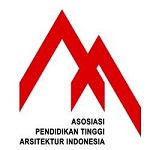Konsep Arsitektur Surya Pasif pada Bangunan Masjid Raja Haji Fisabilillah di Malaysia
Abstract
ABSTRAK: Indonesia sebagai negara tropis mendapatkan sinar matahari yang cukup intens setiap tahunnya, sehingga seringkali membuat bangunan di Indonesia menjadi kurang nyaman dan berdampak pada penggunaan AC yang berlebihan. Dibutuhkan pengetahuan mengenai desain bangunan yang mengedepankan teknik pasif, seperti Konsep Arsitektur Surya Pasif yang memperhatikan aspek pedinginan alami (kenyamanan termal) dan pencahayaan alami pada desainnya, penelitian ini bertujuan agar dapat diketahui hal-hal yang perlu dipertimbangkan dalam penerapan konsep arsitektur surya pasif sehingga harapan kedepan banyak bangunan di Indonesia yang dapat menerapkan desain surya pasif khususnya pada bangunan peribadatan masjid. Penelitian ini dilakukan dengan metode deskriptif kualitatif. Setiap aspek yang bekaitan dengan topik penelitian dijelaskan dengan cara deskripsi dan berdasarkan kebenaran dari suatu teori mengenai penerapan desain Arsitektur Surya Pasif yang memperhatikan aspek pendinginan alami (kenyamanan termal) dan pencahayaan alami yang diterapkan melalui desain orientasi bangunan, bahan material yang digunakan serta elemen-elemen desain bangunan lainnya seperti lantai, dinding, atap, langit-langit, dan aksesoris bangunan. Penelitian ini dilakukan pada bangunan peribadatan Masjid Raja Haji Fisabilillah di Malaysia. Hasil dari penelitian ini, Masjid Raja Haji Fisabilillah menerapkan desain surya pasif pada rancangan desainnya. Aspek-aspek Surya pasif seperti aspek pendinginan alami (kenyamanan termal) dan aspek pencahayaan alami sangat diperhatikan oleh sang arsitek bangunan ini.
ABSTRACT: Indonesia as a tropical country gets intense sunlight every year, so it often makes buildings in Indonesia uncomfortable and results in excessive use of air conditioning. Knowledge is needed about building designs that prioritize passive techniques, such as the Passive Solar Architectural Concept which pays attention to natural cooling (thermal comfort) and natural lighting in its design, this study aims to find out what needs to be considered in applying the concept of passive solar architecture so that expectations in the future, many buildings in Indonesia can apply passive solar designs, especially in mosque worship buildings. This research was conducted using a qualitative descriptive method. Every aspect related to the research topic is explained in a descriptive manner and based on the truth of a theory regarding the application of Passive Solar Architecture design which takes into account the aspects of natural cooling (thermal comfort) and natural lighting which is applied through the design of the orientation of the building, the materials used and the elements. other building designs such as floors, walls, roofs, ceilings, and building accessories. This research was conducted in the worship building of the Raja Haji Fisabilillah Mosque in Malaysia. The results of this study, the Raja Haji Fisabilillah Mosque applied a passive solar design in its design. Passive solar aspects such as aspects of natural cooling (thermal comfort) and aspects of natural lighting are very much considered by the architect of this building.
Keywords
Full Text:
PDFReferences
P. Kemdikbud, "Keunggulan Lokasi Indonesia," Pustekkom Kemdikbud, 2019. https://sumber.belajar.kemdikbud.go.id/repos/FileUpload/Keunggulan letak indonesia-B B/Topik-1 .html (Diakses pada 20 Maret 2020).
H. Saleh et al, "Does Green Building Index (GBI) Masjid Follows Islamic Based Development (IBD)?" International Journal of Academic Research in Business and Social Sciences, vol. 7, no. 2, pp. 719-725, 2017.
J. Priatman, "Perspektif Arsitektur Surya di Indonesia," DIMENSI (Journal of Architecture and Built Environment), vol. 28, no. 1, 2000.
J. Kachadorian, The Passive Solar House: Using Solar Design to Cool and Heat Your Home. Chelsea Green Publishing, 2006.
P. W. Niles and K. L. Haggard, "Passive Solar Handbook," California Energy Commission, Sacramento (USA), Tech. Rep., 1980.
F. Allard, "Natural Ventilation in Buildings, A Design Handbook," 1998.
M. Santamouris and D. Asimakopoulos, Passive Cooling of Buildings. Earthscan, 1996.
J. O'Conner, E. Lee, F. Rubinstein, and S. Selkowitz, "Tips for Day Lighting With Windows," 1997.
S. Education, "Iklim Malaysia," SUN Education Grup, 2014. https://suneducationgroup.com/news-id/iklim-malaysia/ (Diakses pada 12 April 2014).
D. Nikolic, J. Skerlic, D. Cvetkovic, J. Radulovic, and S. Jovanovic, "Basic Principles of Passive Solar Heating," in 3rd International Conference on Quality of Life, Kopaonik, Serbia, 2018, pp. 28-30.
DOI: https://doi.org/10.26618/j-linears.v4i1.5210
Copyright (c) 2021 Jurnal Linears

This work is licensed under a Creative Commons Attribution-NoDerivatives 4.0 International License.

Jurnal Linears is licensed under a Creative Commons Attribution-NonCommercial-NoDerivatives 4.0 International License.









